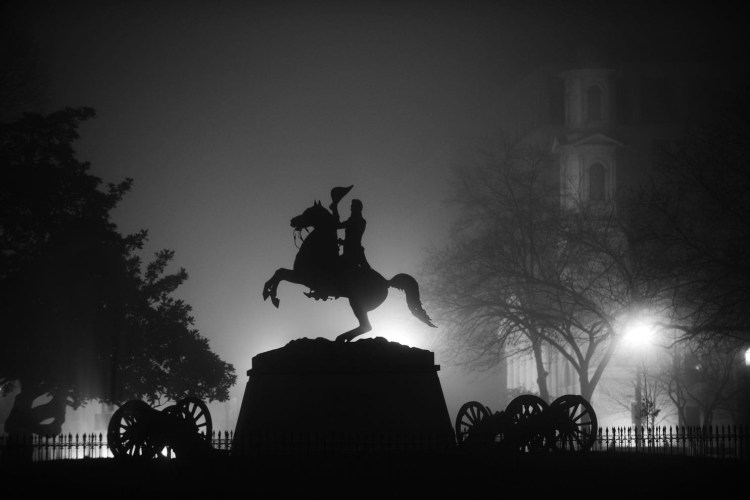During the War of 1812, roughly two decades before he became president, Gen. Andrew Jackson wrote home to his wife, Rachel, from the battlefield.
Though he was tired and banged up, Jackson was also proud. He had just presided over another successful slaughter of Native Americans.
“I detached Genl John Coffee with part of his Brigade of Cavalry and mounted men to destroy Creek Town,” he wrote, referring to an area in what is now Alabama.
The general, Jackson wrote, had performed this slaughter in “elegant” style. More than 170 Native Americans were killed. Still, there was more killing to do. He was determined to march on, he wrote, to “the heart of the creek nation.”
This letter, to historians, is a key document in Jackson’s life – but not because it describes a pattern of behavior toward Native Americans that Jackson continued for decades. Rather, it’s because of the bizarre coda written by the president responsible for the Indian Removal Act of 1830 and, later, the Trail of Tears.
“I send on a little Indian boy,” he wrote.
The baby boy’s family had been wiped out. Jackson arranged for him to be transported to his plantation, the Hermitage, where he would grow up as Rachel and the future president’s adopted child. They named him Lyncoya, and Jackson referred to him as his son.
There are a few ways of reflecting on and telling the story of Lyncoya. One is the this-muddies-the-water view of history.
The National Park Service puts it this way in a brief informational biography of Lyncoya: “The adoption of the young battlefield survivor complicates our understanding of Andrew Jackson’s attitude toward Indians.”
Another way is the but-he-was-actually-a-good-guy sentiment expressed by Jim Webb, the former senator from Virginia, in a 2016 Washington Post opinion piece arguing that Jackson – called genocidal by some critics – should not be replaced on the $20 bill by abolitionist Harriet Tubman.
“It would be difficult,” Webb wrote, “to call someone genocidal when years before, after one bloody fight, he brought an orphaned Native American baby from the battlefield to his home in Tennessee and raised him as his son.”
And finally, there is the view of historians who have studied Jackson’s political and social motivations in context with the times.
“I get that there is a kind of sentimental narrative that people want to promote about this story,” said Emory University historian Dawn E. Peterson, “but that sentimental narrative eliminates what Andrew Jackson was really doing.”
Peterson, in her 2017 book, “Indians in the Family: Adoption and the Politics of Antebellum Expansion,” examines what Jackson was really doing and her assessment will not qualify Jackson for inclusion on a Hallmark card for Father’s Day.
“In an invasion that became notorious for its brutality,” she wrote, “Jackson’s adoption of a young Creek boy into his plantation household transformed the meaning of the event from a unilateral act of war – largely against noncombatants – into an act of benevolence.”
In other words, Jackson was just being politically expedient. The conditions were ripe for him to make such a move.
For starters, there was his own life story.
Jackson had been an orphan. He and Rachel were not able to have kids of their own. They had already adopted or taken in several children, including Rachel’s nephew, Andrew Jackson Jr.
Now Jackson was taking in this baby whose parents had been killed by his own orders.
Redemption. Dad of the year!
No.
When Jackson wrote Rachel about the baby, he said the boy was “for Andrew” – almost like a gift.
“He actually called him a pet,” Peterson said in an interview. “He was not going to be a full-fledged member of the family.”
Lyncoya did live in the house with the family and was given a good education. At one point, Jackson tried to get him into West Point.
Instead, Jackson sent him to become a saddler. This wasn’t an easy life. At age 16, Lyncoya contracted tuberculosis and died. He was buried in an unmarked grave.
And Jackson, Peterson said, made sure his early biographers knew Lyncoya’s story – about how Jackson saved the little Native American boy. It was pure spin, and plenty of historians fell for it.
“I don’t think that’s an accurate reading of what happened here,” Peterson said.
Send questions/comments to the editors.



Success. Please wait for the page to reload. If the page does not reload within 5 seconds, please refresh the page.
Enter your email and password to access comments.
Hi, to comment on stories you must . This profile is in addition to your subscription and website login.
Already have a commenting profile? .
Invalid username/password.
Please check your email to confirm and complete your registration.
Only subscribers are eligible to post comments. Please subscribe or login first for digital access. Here’s why.
Use the form below to reset your password. When you've submitted your account email, we will send an email with a reset code.